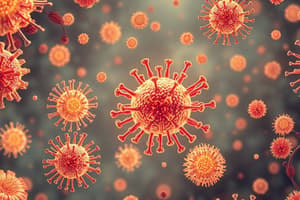Podcast
Questions and Answers
What is described as our first line of defense against pathogens?
What is described as our first line of defense against pathogens?
- The immune system
- Skin (correct)
- Mucus membranes
- Respiratory system
Which of the following contributes to the chemical barrier provided by the skin?
Which of the following contributes to the chemical barrier provided by the skin?
- Secreting oils and acids (correct)
- Generating new cells
- Creating a thick epidermis
- Increasing blood flow
What role do virulence factors play in microbial pathogenicity?
What role do virulence factors play in microbial pathogenicity?
- They prevent the host from producing other defenses.
- They also function as nutrients for the host.
- They enhance the pathogen's ability to cause disease. (correct)
- They increase the host's immune response.
What is one common mechanism by which pathogens employ anti-phagocytic factors?
What is one common mechanism by which pathogens employ anti-phagocytic factors?
Which statement about the interactions between hosts and pathogens is accurate?
Which statement about the interactions between hosts and pathogens is accurate?
An example of a type of virulence factor is:
An example of a type of virulence factor is:
What happens when trauma to the skin occurs?
What happens when trauma to the skin occurs?
Which mechanism does NOT impede phagocytosis?
Which mechanism does NOT impede phagocytosis?
The term virulence factors specifically refers to substances produced by pathogens that:
The term virulence factors specifically refers to substances produced by pathogens that:
Phagocytosis is vital for our defense because it:
Phagocytosis is vital for our defense because it:
What role do exoenzymes play in the pathogenicity of bacteria?
What role do exoenzymes play in the pathogenicity of bacteria?
Which exoenzyme is known for coagulating plasma to prevent white blood cells from reaching the infection site?
Which exoenzyme is known for coagulating plasma to prevent white blood cells from reaching the infection site?
What is a characteristic of exotoxins compared to endotoxins?
What is a characteristic of exotoxins compared to endotoxins?
Which of the following is true regarding endotoxins?
Which of the following is true regarding endotoxins?
What is a common impact of endotoxins when released into the host's system?
What is a common impact of endotoxins when released into the host's system?
Which type of toxin is generally more potent and acts in smaller quantities?
Which type of toxin is generally more potent and acts in smaller quantities?
What is the main reason hyaluronidase is referred to as the 'spreading factor'?
What is the main reason hyaluronidase is referred to as the 'spreading factor'?
Which of the following best differentiates exotoxins from toxins produced by plants and animals?
Which of the following best differentiates exotoxins from toxins produced by plants and animals?
What is the other name commonly associated with endotoxins?
What is the other name commonly associated with endotoxins?
What describes the relationship between toxins and their targets in the body?
What describes the relationship between toxins and their targets in the body?
The skin acts as a barrier against pathogens and is referred to as our first line of defense.
The skin acts as a barrier against pathogens and is referred to as our first line of defense.
Virulence factors are substances produced by pathogens that decrease their ability to cause disease.
Virulence factors are substances produced by pathogens that decrease their ability to cause disease.
A glycocalyx can impede the phagocytosis of bacteria by white blood cells.
A glycocalyx can impede the phagocytosis of bacteria by white blood cells.
Trauma to the skin does not allow any infectious agents to enter the human body.
Trauma to the skin does not allow any infectious agents to enter the human body.
Phagocytosis is not critical to our immune defense against infections.
Phagocytosis is not critical to our immune defense against infections.
Anti-phagocytic factors help pathogens survive by preventing their ingestion by white blood cells.
Anti-phagocytic factors help pathogens survive by preventing their ingestion by white blood cells.
All microbes have the ability to produce virulence factors.
All microbes have the ability to produce virulence factors.
Some enzymes can inhibit the phagocytosis process, allowing bacteria to survive inside white blood cells.
Some enzymes can inhibit the phagocytosis process, allowing bacteria to survive inside white blood cells.
Microbes that make use of virulence factors are never able to evade host defenses.
Microbes that make use of virulence factors are never able to evade host defenses.
The skin releases acids and salts that create a chemical barrier against pathogens.
The skin releases acids and salts that create a chemical barrier against pathogens.
Exoenzymes are enzymes made and secreted by bacteria that can damage host tissues.
Exoenzymes are enzymes made and secreted by bacteria that can damage host tissues.
Coagulase is an exoenzyme that facilitates the entry of white blood cells to the site of infection.
Coagulase is an exoenzyme that facilitates the entry of white blood cells to the site of infection.
Hyaluronidase is also known as 'spreading factor' because it helps bacteria disseminate through host tissues.
Hyaluronidase is also known as 'spreading factor' because it helps bacteria disseminate through host tissues.
Exotoxins are less potent than endotoxins and are released when bacterial cells die.
Exotoxins are less potent than endotoxins and are released when bacterial cells die.
Endotoxins are proteins that can be produced by both Gram-positive and Gram-negative bacteria.
Endotoxins are proteins that can be produced by both Gram-positive and Gram-negative bacteria.
Exotoxins tend to target specific tissues in the body, such as muscles and the gastrointestinal tract.
Exotoxins tend to target specific tissues in the body, such as muscles and the gastrointestinal tract.
The primary role of endotoxins is to coagulate blood and form clots in the host.
The primary role of endotoxins is to coagulate blood and form clots in the host.
Both exotoxins and endotoxins can be harmful to the host, but they differ in their potency and release mechanism.
Both exotoxins and endotoxins can be harmful to the host, but they differ in their potency and release mechanism.
Poisonous plants and animals cannot produce toxins like microbes can.
Poisonous plants and animals cannot produce toxins like microbes can.
Endotoxin is also known as Lipopolysaccharide (LPS), which is part of the Gram-negative bacterial cell wall.
Endotoxin is also known as Lipopolysaccharide (LPS), which is part of the Gram-negative bacterial cell wall.
Flashcards are hidden until you start studying
Study Notes
Skin as a Barrier
- Skin is the first line of defense against pathogens.
- Skin provides both a physical and chemical barrier.
- Trauma to the skin allows pathogens to enter the body.
Pathogen-Host Interactions
- Pathogen-host interactions resemble a strategic battle.
- The host has defenses, and the pathogen develops mechanisms to evade them.
- Virulence factors are substances produced by pathogens to overcome host defenses.
Virulence Factors
- Virulence factors increase the pathogenicity of microbes.
- Three common types of virulence factors are:
- Anti-phagocytic factors
- Exoenzymes
- Toxins
Anti-Phagocytic Factors
- Some microbes have evolved mechanisms to block phagocytosis by white blood cells (WBCs).
- Examples of anti-phagocytic factors include:
- Glycocalyx: A capsule or slime layer that hinders phagocytosis.
- Proteins or enzymes: Inhibit the phagocytosis process, preventing destruction of the bacterium.
- Intracellular survival: Some bacteria live inside WBCs.
Exoenzymes
- Exoenzymes are enzymes produced and secreted by bacteria that damage host tissues.
- Examples of exoenzymes include:
- Coagulase: Forms clots, preventing WBC access.
- Hyaluronidase: "Spreading factor," allowing bacteria to spread by digesting host tissues.
Toxins
- Toxins are poisonous substances produced by one organism that harm another.
- There are two main types of microbial toxins:
- Exotoxins: Proteins made by living cells and secreted into the environment; potent and target specific tissues.
- Endotoxins: Lipopolysaccharide (LPS) found in Gram-negative bacteria, released upon cell death; less potent than exotoxins, but with more systemic effects, often causing fever.
Exotoxins
- Examples of exotoxins include:
- Enterotoxins: Affect the gastrointestinal tract.
- Neurotoxins: Affect the nervous system.
Endotoxins
- Endotoxins are a component of the Gram-negative cell wall.
- Endotoxins act as pyrogens, triggering fever.
Skin as a First Line of Defense
- Skin acts as a barrier against external pathogens and environmental threats.
- Skin's varied tissue layers prevent microbial entry.
- Skin secretions, including acids, salts, oils, and chemicals, create a chemical barrier against microbes.
- Trauma to the skin can allow infectious agents to enter, leading to various diseases.
Virulence Factors
- Virulence factors are produced by pathogens to overcome host defenses and cause disease.
- These factors enhance pathogenicity and help pathogens avoid being neutralized by the host.
- Three key types of virulence factors include anti-phagocytic factors, exoenzymes, and toxins.
Anti-Phagocytic Factors
- Phagocytosis by white blood cells (WBCs) is a crucial part of the host's defense system.
- Some microbes have evolved mechanisms to evade phagocytosis, preventing their destruction by WBCs.
- Examples of anti-phagocytic factors include:
- Glycocalyx: Capsules or slime layers can impede or prevent phagocytosis.
- Specific proteins or enzymes: These can inhibit the phagocytosis process, allowing bacteria to survive within WBCs.
Exoenzymes
- Exoenzymes are enzymes produced and secreted by bacteria that can damage host tissues, contributing to virulence.
- Examples of exoenzymes include:
- Coagulase: Coagulates plasma to form clots, potentially hindering WBC access.
- Hyaluronidase: Breaks down host tissues, allowing bacteria to spread.
Toxins
- Toxins are poisonous substances produced by one organism that can harm another organism.
- Microbes are not the only toxin producers; animals, fungi, and plants also produce toxins.
- There are two main types of microbial toxins:
- Exotoxins: Proteins produced by living cells that are released into the environment.
- Potent and often target specific tissues.
- Examples include enterotoxins (affecting the gastrointestinal tract) and neurotoxins (affecting the nervous system).
- Endotoxins: Lipopolysaccharide (LPS) found in the cell walls of Gram-negative bacteria.
- Released when Gram-negative bacteria die and rupture.
- Less potent than exotoxins but often have systemic effects.
- Can trigger fever by acting as a pyrogen.
- Exotoxins: Proteins produced by living cells that are released into the environment.
Studying That Suits You
Use AI to generate personalized quizzes and flashcards to suit your learning preferences.




